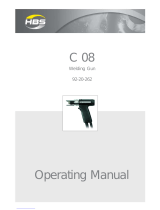
NS-40 Manual Page 13 Revision 1.13 January 2012
STUD WELDING SAFETY PRECAUTIONS
General: To avoid serious risk of injury or death, disconnect the welding unit from any power source then unplug all cables from the welding source to the gun itself before performing
any maintenance at all. Stud welding, as with any welding process, can be dangerous if the equipment is not properly installed and maintained or if the operator does not use the
process with proper safety precautions. The operator should read and understand these precautions and be trained or experienced In the installation, operation, and maintenance
procedures provided in this Nelson manual.
Electrical: Remember, electric shock can kill! Properly install and use stud welding systerns in accordance with the National Electrical Code NFPA-70 and local codes. Take the
following safety precautions:
• Do not touch live electrical parts: be sure you are Insulated from same
• Be certain that the equipment is properly grounded and that all weld cables and connectors are In good condition. Inspect the cables, connections, etc. regularly for frays,
broken insulation, insulators or other electrical hazards and repair or replace them at once.
• Do not work in wet areas or weld when you are wet.
• Wear proper clothing at all times and when gloves are necessary due to welding position, be sure that they are dry, insulated, and have no holes.
Fire Protection: Remove all combustible or volatile materials from the work area. Although weld spatter or berries resulting from stud welding are minimal, proper precautions should be
taken when welding near or through combustible materials to be sure that sparks or berries cannot reach and ignite them. Store and restrain gas cylinders properly. Be sure that they
never become a part of an electrical circuit and are isolated from excessive heat or welding spatter and berries. Always have fire suppression equipment available for immediate use
and know how to use it.
Vision Protection: It is recommended that eye protection be worn by the operator at all times when welding. Eye glasses with spectacle frames equipped with Shade No.3 absorption
and filter lenses and side shields are suggested. Helpers or workers within five (5) feet of a welding operation should wear clear safety glasses with side shields. For additional
Information consult ANSI Standard Z87.1.
Hearing Protection: It is recommended that proper ear protection be used when operating or working within five (5) feet of all capacitor discharge stud welding systems. Other stud
welding operations in confined environments should be evaluated for noise level and hearing protection need. Consult OSHA standard 29 CFR, Part 1910, Subpart Q, "Welding,
Cutting, and Brazing" for additional information.
Protective Clothing: The use of protective clothing is recommended. The type of protection will vary with the stud welding process, application, weld position and stud size being
welded, but flame resistant clothing, including high boots, gloves, apron, leather leggings, etc., should be considered to protect the operator from welding spatter, arc flash and berries if
required. In all cases during welding do not wear clothing made from flammable, synthetic fabrics. For information see ANSI/AWS Z49.1, "Safety in Welding and Cutting".
Ventilation: Continuous welding in a closed area or welding and cleaning materials with paint, epoxy, galvanizing or other coatings, can produce fumes that are unhealthy. Natural or
forced ventilation in the welding area should be provided as necessary to prevent fume accumulation. Material Safety Data Sheets (MSDS) should be supplied by the material suppliers
for materials used in the welding process and evaluated for dangerous contents that would produce toxic fumes or gasses.
Other: Keep hands, clothing, tools, feet, etc. away from the weld stud, chuck and other moving parts during the weld cycle to avoid pinch points or electric shock.
Maintenance: Warning - Use extreme caution when servicing or troubleshooting any electrical component of the stud welding system. If possible, turn off all power and disconnect all
electrical cables and follow the manufacturer's maintenance and service procedures. Capacitor Discharge (CD) stud welding equipment may retain a very high electrical charge in the
capacitor bank even after being shut off. Follow the manufacturers instructions for discharging or draining the capacitor bank before servicing CD equipment.
References
• AWS pamphlet "Arc Welding Safety"
• ANSI/AWS Standard Z49 1 "Safety In Welding and Cutting"
• ANSI Standard Z87. 1 "Safe Practice for Occupation and Educational Eye and Face Protection"
• ANSI/AWS C5.4 "Recommended Practices for Stud Welding"
Available from:
American National Standards Institute
1430 Broadway
-or- American Welding Society
550 N W LeJeune Road
• OSHA Standard 29CFR. Part 1910. Subpart Q "Welding, Cutting, and Brazing”
Available from:
Superintendent of Documents
U.S. Government Printing Office
Washington, D.C. 20402
• CSA Standard W117.2 "Code for Safety in Welding and Cutting"
Available from:
Canadian Standards Association
178 Rexdale Blvd.
Rexdale, Ontario M9W-1R3
• NFPA -70 National Electrical Code
Available from:
National Fire Protection Association
Batterymarch Park
Quincy, Ma. 2269



















